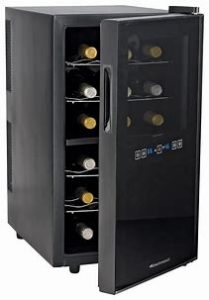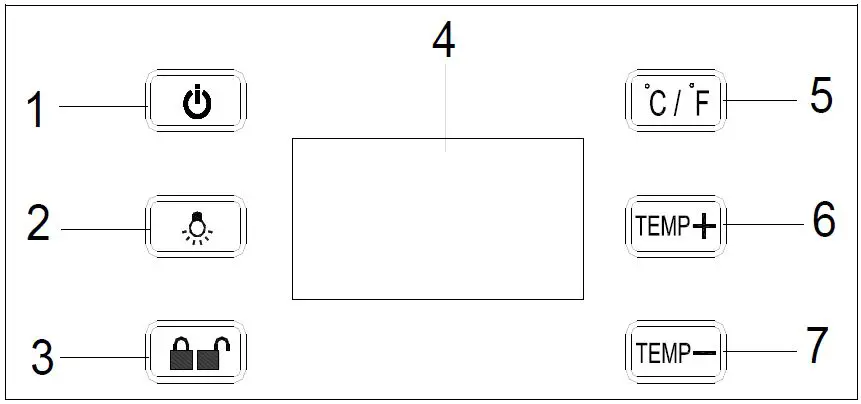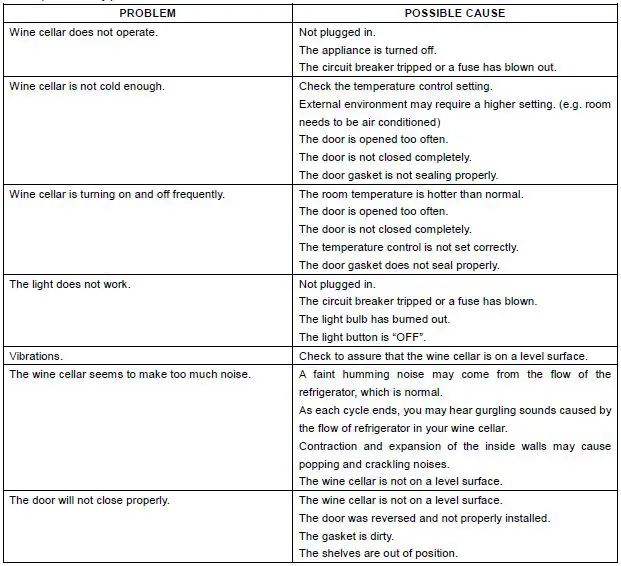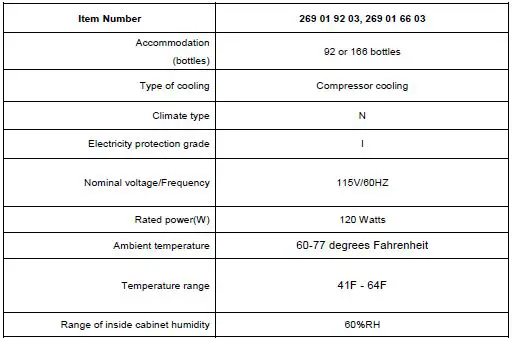

Freestanding, Classic Black Wine Refrigerators
269 01 92 03, 269 01 66 03
INSTRUCTION MANUAL
PLEASE READ THIS MANUAL CAREFULLY BEFORE INSTALLING AND OPERATING.
Wine Cellar Package Contents
- Instruction manual
- Shelves
IMPORTANT SAFETY INSTRUCTIONS
WARNING
To reduce the risk of fire, electrical shock, or injury when using your appliance, follow these basic precautions:
- Read all instructions before using the wine cellar.
- DANGER: Risk of child becoming trapped in new cellar, old wine cellar/refrigeration unit, or large boxes.
Junked or abandoned appliances, boxes and other containers are still dangerous, even if they will “just sit in the garage for a few days”. - Before you throw away your old wine cellar or refrigeration unit: 1. Take off the door. 2. Leave the shelves in place so that children cannot climb inside.
- Never allow children to operate, play with, or crawl inside the appliance.
- Never clean appliance parts with flammable fluids. The fumes can create a fire hazard or explosion.
- Do not store in the vicinity of any other appliance. Do not store near gasoline or any other flammable vapors. The fumes can create a fire hazard or explosion.
BEFORE USING YOUR WINE CELLAR
- Remove the exterior and interior packaging.
- Before connecting the wine cellar to the power source, let it stand upright for approximately 2 hours. This will reduce the possibility of a malfunction in the cooling system from handling during transportation.
- Clean the interior surface with lukewarm water using a soft cloth.
INSTALLATION INSTRUCTIONS
General Installation Instructions
- This appliance is designed for free standing installation. Do not build-in or recess into closed cabinetry.
- Place your wine cellar on a flat, solid floor that is strong enough to support it when it is fully loaded. To level your wine cellar, adjust the front leveling leg at the bottom of the wine cellar.
- When moving your wine cellar, please do not incline it more than 45 degrees.
- Locate the wine cellar away from direct sunlight and sources of heat (stove, heater, radiator, etc.). Direct sunlight may affect the acrylic coating and heat sources may increase electrical consumption. Extreme cold ambient temperatures may also cause the unit to perform improperly.
- Avoid locating the unit in damp areas.
- Plug the wine cellar into a dedicated (for this appliance only), properly installed and grounded wall outlet. Do not under any circumstances cut or remove the third (grounding) prong from the power cord. Any questions concerning power and/or electrical grounding should be directed to a certified electrician or authorized product service center.
Operating Your Wine Cellar
Setting the Temperature Control/Display panel
Temperature Control
Control Panel
- Power button – Turns the wine refrigerator on or off.
- Light Control Button – Turns the light inside the wine refrigerator on or off.
- Lock/Unlock Key – Locks the control panel so the temperature cannot be changed.
- LCD Display – Displays the temperature inside the wine refrigerator, light function, and lock/unlock status.
- Celsius / Fahrenheit Selector Button – Changes temperature reading to Celsius or Fahrenheit.
- Temperature Increase Button – Increases temperature by 1 degree.
- Temperature Decrease Button – Decreases temperature by 1 degree.
TEMPERATURE SETTINGS FOR SERVING WINE
Although optimal storage temperature is generally regarded to be 53-57°F, different varietals of wine require different service temperature settings. The recommended temperature ranges for serving different varietals of wine are listed below. Your wine cellar will indicate when you have set the Upper/Lower zones to the below temperature ranges.
- Red Wines: 60-66°F
- White Wines 45-52°F
- Sparkling Wines 40-45°F
LAYOUT AND STORAGE
Your cabinet was designed to store a maximum number of bottles securely. We recommend that you observe the tips below to optimize loading.
- Remove tape from shelves once unit is stable and ready for storage.
- Disperse the bottles evenly to avoid concentrating weight in one place. Bottles must not touch either the back of the cabinet.
- Make sure that the bottles are not all grouped together either at the top or bottom of the cabinet.
- Only pull out one shelf at a time. Never attempt to pull more than one.
- Maximum weight capacity per shelf is 55 lbs.
- You can increase your wine cellar’s storage capacity by removing shelves and stacking bottles on top of one another. Do not stack more than 3 rows of bottles per shelf.
- Each sliding shelf is designed to comfortably hold one row of 11 bottles in our 166 bottle model wine refrigerator and 6 bottles in our 92 bottle wine refrigerator. You can also fit up to 12 bottles on the bottom of the cabinet, inside the basket.
CARE AND MAINTENANCE
Cleaning Your Wine Cellar.
- Turn off the power, unplug the appliance, and remove all items including all shelves.
- Wash the inside surfaces with a solution of warm water and baking soda (approximately 2 tablespoons of baking soda for each quart of water.)
- Wash the shelves with a mild detergent solution.
- Wring excess water out of the sponge or cloth when cleaning area of the controls, or any electrical parts.
- Wash the outside of the cabinet with warm water and mild liquid detergent. Rinse well and wipe dry with a clean soft cloth.
- Vacuum the front grill and back of the unit twice yearly. Make sure the power is off before cleaning.
- It is recommended to clean the unit completely inside and out once a year to maximize the longevity of the wine cellar.
Power Loss
- Power failures that are corrected within a few hours should not affect the temperature of your appliance if you minimize the number of times the door is opened. If the power is going to be off for a longer period of time, you need to take other measures to protect your contents.
- If the unit is unplugged, loses power, or is turned off, you must wait 3 to 5 minutes before restarting. Attempting to restart the wine cellar before this time has elapsed may prevent the wine cellar from starting.
Absence/Vacation
- Short vacations: You may leave the wine cellar powered on and unattended for absences of less than three (3) weeks.
- Long vacations: If the appliance will not be used for more than three weeks, remove all items and turn off the appliance. Clean and dry the interior thoroughly. To prevent mold growth, leave the door open slightly, blocking it open if necessary.
Moving Your Wine Cellar
- Remove all items.
- Securely tape down all loose items (shelves) inside your appliance.
- Turn the adjustable leg up to the base to avoid damage.
- Tape the door shut.
- Be sure the appliance stays secure in the upright position during transportation. Also protect the outside of the appliance with a blanket or similar item.
Energy saving Tip
- The wine cellar should be located in the coolest area of the room, away from heat producing appliances, and away from direct sunlight.
TROUBLESHOOTING GUIDE
Many common issues with your wine cellar can be solved very easily. Try the troubleshooting tips below should you experience any problems.

TECHNICAL DATA

WARRANTY INFORMATION
Please speak to your retailer before calling Wine Enthusiast if you did not purchase your wine cellar directly from Wine Enthusiast.
Limited warranty – 90-day replacement plan with a free 9-month upgrade, totaling 1 year, on parts and labor from the date of shipment. For customer service, please contact Wine Enthusiast by e-mail ([email protected]) or by phone (800.648.6058).
The limited warranty does not cover: Damage due to such things as accident, misuse, abuse, mishandling, neglect, unauthorized repair or any other cause beyond the control of the seller whether similar or dissimilar to the foregoing. Purchaser understands and acknowledges that the goods sold here are wine refrigerators, which house wine. Purchaser assumes all the risk of using these units, including risk of spoilage, humidity variations, temperature variations, leaks, fires, water damage, mold, mildew, dryness and similar perils that may occur.